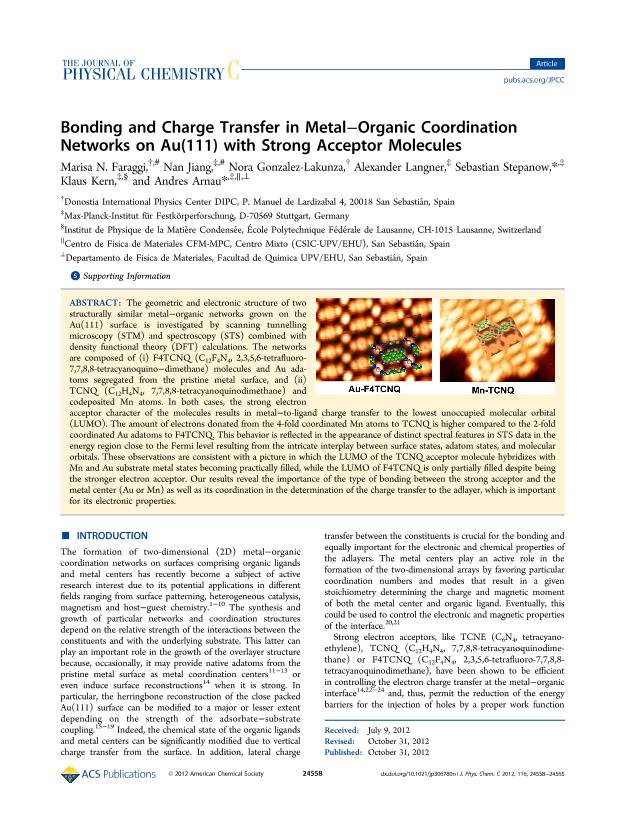Mostrar el registro sencillo del ítem
dc.contributor.author
Faraggi, Marisa Noemi

dc.contributor.author
Jiang, Nan
dc.contributor.author
Gonzalez Lakuntza, Nora

dc.contributor.author
Langner, Alexander
dc.contributor.author
Stepanow, Sebastian
dc.contributor.author
Kern, Klaus
dc.contributor.author
Arnau, Andres
dc.date.available
2017-07-04T20:09:04Z
dc.date.issued
2012-10
dc.identifier.citation
Faraggi, Marisa Noemi; Jiang, Nan; Gonzalez Lakuntza, Nora; Langner, Alexander; Stepanow, Sebastian; et al.; Bonding and Charge Transfer in Metal–Organic Coordination Networks on Au(111) with Strong Acceptor Molecules; American Chemical Society; Journal of Physical Chemistry C; 116; 10-2012; 24558-24565
dc.identifier.issn
1932-7447
dc.identifier.uri
http://hdl.handle.net/11336/19515
dc.description.abstract
The geometric and electronic structure of two structurally similar metal–organic networks grown on the Au(111) surface is investigated by scanning tunnelling microscopy (STM) and spectroscopy (STS) combined with density functional theory (DFT) calculations. The networks are composed of (i) F4TCNQ (C12F4N4, 2,3,5,6-tetrafluoro-7,7,8,8-tetracyanoquino–dimethane) molecules and Au adatoms segregated from the pristine metal surface, and (ii) TCNQ (C12H4N4, 7,7,8,8-tetracyanoquinodimethane) and codeposited Mn atoms. In both cases, the strong electron acceptor character of the molecules results in metal–to-ligand charge transfer to the lowest unoccupied molecular orbital (LUMO). The amount of electrons donated from the 4-fold coordinated Mn atoms to TCNQ is higher compared to the 2-fold coordinated Au adatoms to F4TCNQ. This behavior is reflected in the appearance of distinct spectral features in STS data in the energy region close to the Fermi level resulting from the intricate interplay between surface states, adatom states, and molecular orbitals. These observations are consistent with a picture in which the LUMO of the TCNQ acceptor molecule hybridizes with Mn and Au substrate metal states becoming practically filled, while the LUMO of F4TCNQ is only partially filled despite being the stronger electron acceptor. Our results reveal the importance of the type of bonding between the strong acceptor and the metal center (Au or Mn) as well as its coordination in the determination of the charge transfer to the adlayer, which is important for its electronic properties.
dc.format
application/pdf
dc.language.iso
eng
dc.publisher
American Chemical Society

dc.rights
info:eu-repo/semantics/openAccess
dc.rights.uri
https://creativecommons.org/licenses/by-nc-sa/2.5/ar/
dc.subject
Surface
dc.subject
Network
dc.subject
Molecule
dc.subject
Acceptor
dc.subject.classification
Física de los Materiales Condensados

dc.subject.classification
Ciencias Físicas

dc.subject.classification
CIENCIAS NATURALES Y EXACTAS

dc.title
Bonding and Charge Transfer in Metal–Organic Coordination Networks on Au(111) with Strong Acceptor Molecules
dc.type
info:eu-repo/semantics/article
dc.type
info:ar-repo/semantics/artículo
dc.type
info:eu-repo/semantics/publishedVersion
dc.date.updated
2017-07-04T14:08:43Z
dc.journal.volume
116
dc.journal.pagination
24558-24565
dc.journal.pais
Estados Unidos

dc.journal.ciudad
Washington
dc.description.fil
Fil: Faraggi, Marisa Noemi. Consejo Nacional de Investigaciónes Científicas y Técnicas. Oficina de Coordinación Administrativa Ciudad Universitaria. Instituto de Astronomía y Física del Espacio. - Universidad de Buenos Aires. Facultad de Ciencias Exactas y Naturales. Instituto de Astronomía y Física del Espacio; Argentina. Donostia International Physics Center; España
dc.description.fil
Fil: Jiang, Nan. Max-planck-institut Fu R Festkorperforschung; Alemania
dc.description.fil
Fil: Gonzalez Lakuntza, Nora. Donostia International Physics Center; España
dc.description.fil
Fil: Langner, Alexander. Max-planck-institut Fu R Festkorperforschung; Alemania
dc.description.fil
Fil: Stepanow, Sebastian. Max-planck-institut Fu R Festkorperforschung; Alemania
dc.description.fil
Fil: Kern, Klaus. Max-planck-institut Fur Festkorperforschun; Alemania
dc.description.fil
Fil: Arnau, Andres. Max-planck-institut Fur Festkorperforschun; Alemania
dc.journal.title
Journal of Physical Chemistry C

dc.relation.alternativeid
info:eu-repo/semantics/altIdentifier/doi/http://dx.doi.org/10.1021/jp306780n
dc.relation.alternativeid
info:eu-repo/semantics/altIdentifier/url/http://pubs.acs.org/doi/abs/10.1021/jp306780n
Archivos asociados
